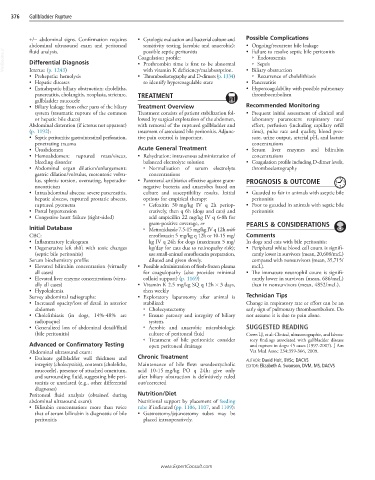Page 791 - Cote clinical veterinary advisor dogs and cats 4th
P. 791
376 Gallbladder Rupture
+/− abdominal signs. Confirmation requires • Cytologic evaluation and bacterial culture and Possible Complications
abdominal ultrasound exam and peritoneal sensitivity testing (aerobic and anaerobic): • Ongoing/recurrent bile leakage
VetBooks.ir Differential Diagnosis Coagulation profile: ○ Endotoxemia
• Failure to resolve septic bile peritonitis
possible septic peritonitis
fluid analysis.
• Prothrombin time is first to be abnormal
○ Sepsis
with vitamin K deficiency/malabsorption.
Icterus: (p. 1243)
○ Recurrence of cholelithiasis
• Prehepatic: hemolysis • Thromboelastography and D-dimers (p. 1334) • Biliary obstruction
• Hepatic diseases to identify hypercoagulable state • Pancreatitis
• Extrahepatic biliary obstruction: choleliths, • Hypercoagulability with possible pulmonary
pancreatitis, cholangitis, neoplasia, stricture, TREATMENT thromboembolism
gallbladder mucocele
• Biliary leakage from other parts of the biliary Treatment Overview Recommended Monitoring
system (traumatic rupture of the common Treatment consists of patient stabilization fol- • Frequent initial assessment of clinical and
or hepatic bile ducts) lowed by surgical exploration of the abdomen, laboratory parameters: respiratory rate/
Abdominal distention (if icterus not apparent) with removal of the ruptured gallbladder and effort, perfusion (including capillary refill
(p. 1192): treatment of associated bile peritonitis. Adjunc- time), pulse rate and quality, blood pres-
• Septic peritonitis: gastrointestinal perforation, tive pain control is important. sure, urine output, arterial pH, and lactate
penetrating trauma concentrations
• Uroabdomen Acute General Treatment • Serum liver enzymes and bilirubin
• Hemoabdomen: ruptured mass/viscus, • Rehydration: intravenous administration of concentrations
bleeding disorder balanced electrolyte solution • Coagulation profile including D-dimer levels,
• Abdominal organ dilation/enlargement: ○ Normalization of serum electrolyte thromboelastography
gastric dilation/volvulus, mesenteric volvu- concentrations
lus, splenic torsion, overeating, hyperadre- • Parenteral antibiotics effective against gram- PROGNOSIS & OUTCOME
nocorticism negative bacteria and anaerobes based on
• Intraabdominal abscess: severe pancreatitis, culture and susceptibility results. Initial • Guarded to fair in animals with aseptic bile
hepatic abscess, ruptured prostatic abscess, options for empirical therapy: peritonitis
ruptured pyometra ○ Cefoxitin 30 mg/kg IV q 2h periop- • Poor to guarded in animals with septic bile
• Portal hypertension eratively, then q 6h (dogs and cats) and peritonitis
• Congestive heart failure (right-sided) add ampicillin 22 mg/kg IV q 6-8h for
gram-positive coverage, or PEARLS & CONSIDERATIONS
Initial Database ○ Metronidazole 7.5-15 mg/kg IV q 12h with
CBC: enrofloxacin 5 mg/kg q 12h or 10-15 mg/ Comments
• Inflammatory leukogram kg IV q 24h for dogs (maximum 5 mg/ In dogs and cats with bile peritonitis:
• Degenerative left shift with toxic changes kg/day for cats due to retinopathy risk); • Peripheral white blood cell count is signifi-
(septic bile peritonitis) use small-animal enrofloxacin preparation, cantly lower in survivors (mean, 20,608/mcL)
Serum biochemistry profile: diluted and given slowly. compared with nonsurvivors (mean, 35,715/
• Elevated bilirubin concentration (virtually • Possible administration of fresh-frozen plasma mcL).
all cases) for coagulopathy (also provides minimal • The immature neutrophil count is signifi-
• Elevated liver enzyme concentrations (virtu- colloid support) (p. 1169) cantly lower in survivors (mean, 686/mcL)
ally all cases) • Vitamin K 2.5 mg/kg SQ q 12h × 3 days, than in nonsurvivors (mean, 4852/mcL).
• Hypokalemia then weekly
Survey abdominal radiographs: • Exploratory laparotomy after animal is Technician Tips
• Increased opacity/loss of detail in anterior stabilized: Change in respiratory rate or effort can be an
abdomen ○ Cholecystectomy early sign of pulmonary thromboembolism. Do
• Cholelithiasis (in dogs, 14%-48% are ○ Ensure patency and integrity of biliary not assume it is due to pain alone.
radiopaque) system.
• Generalized loss of abdominal detail/fluid ○ Aerobic and anaerobic microbiologic SUGGESTED READING
(bile peritonitis) culture of peritoneal fluid Crews LJ, et al: Clinical, ultrasonographic, and labora-
○ Treatment of bile peritonitis: consider tory findings associated with gallbladder disease
Advanced or Confirmatory Testing open peritoneal drainage and rupture in dogs: 45 cases (1997-2007). J Am
Abdominal ultrasound exam: Vet Med Assoc 234:359-366, 2009.
• Evaluate gallbladder wall thickness and Chronic Treatment AUTHOR: David Holt, BVSc, DACVS
integrity (cholecystitis), contents (choleliths, Maintenance of bile flow: ursodeoxycholic EDITOR: Elizabeth A. Swanson, DVM, MS, DACVS
mucocele), presence of attached omentum, acid 10-15 mg/kg PO q 24h; give only
and surrounding fluid, suggesting bile peri- after biliary obstruction is definitively ruled
tonitis or unrelated (e.g., other differential out/corrected
diagnoses)
Peritoneal fluid analysis (obtained during Nutrition/Diet
abdominal ultrasound exam): Nutritional support by placement of feeding
• Bilirubin concentration: more than twice tube if indicated (pp. 1106, 1107, and 1109):
that of serum bilirubin is diagnostic of bile • Gastrostomy/jejunostomy tubes may be
peritonitis placed intraoperatively.
www.ExpertConsult.com

